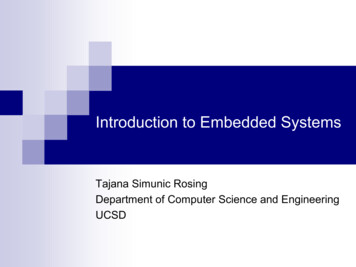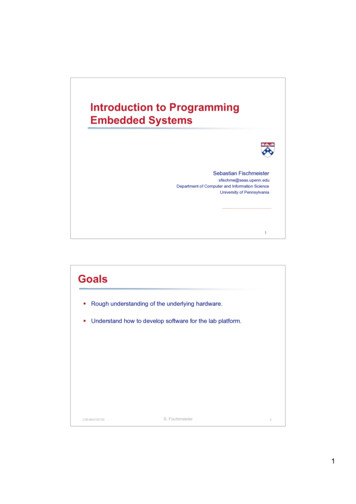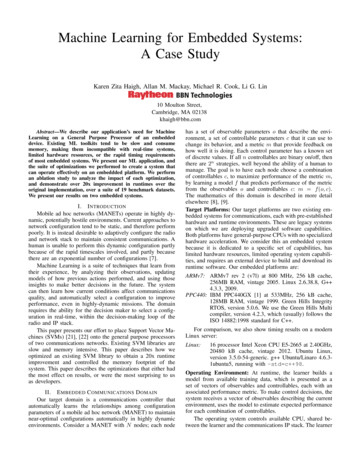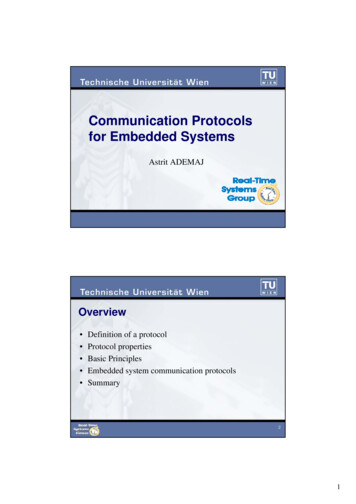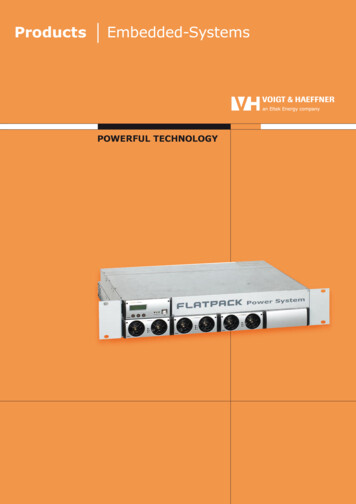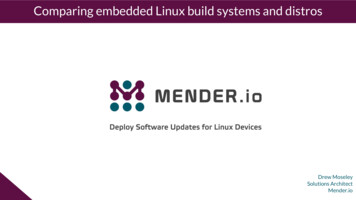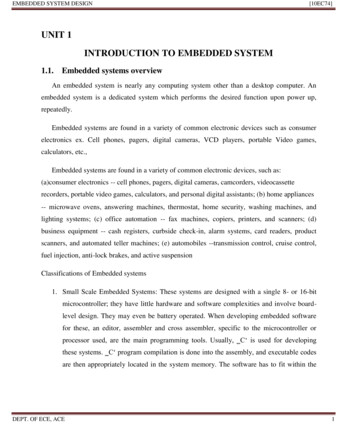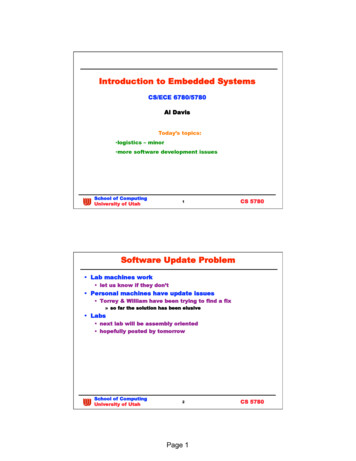
Transcription
Introduction to Embedded SystemsCS/ECE 6780/5780Al DavisToday’s topics: logistics – minor more software development issuesSchool of ComputingUniversity of Utah1CS 5780Software Update Problem Lab machines work let us know if they don’t Personal machines have update issues Torrey & William have been trying to find a fix» so far the solution has been elusive Labs next lab will be assembly oriented hopefully posted by tomorrowSchool of ComputingUniversity of Utah2Page 1CS 5780
Modular SW Development Modular programming breaks SW into distinct and independent modules provides:» functional abstraction to support reuse» complexity abstraction divide and conquer approach» portabilitySchool of ComputingUniversity of Utah3CS 5780Global Variables Global information shared by more than one module use them to pass data between main() and interrupts data is permanent and not deallocated Can use absolute addressing to access globals I/O ports and registers are considered global values it would be silly to view them as locally scopedSchool of ComputingUniversity of Utah4Page 2CS 5780
Local Variables Temporary information used by only one module typically allocated, used, and deallocated» hence information is not permanent Stored on stack or registers dynamic allocation/release allows memory reuse limited scope provides data protection since interrupt saves registers and uses it’s own stack» code may still be re-entrant code is relocatable number of local variables» only limited by stack sizeSchool of ComputingUniversity of Utah5CS 5780Two Local 16-bit Variables: Take 1*X sum and *X 2 n (stack grows down)n and sum are now X relative offsetsSchool of ComputingUniversity of Utah6Page 3CS 5780
Take 1 continuedSchool of ComputingUniversity of Utah7CS 5780Two Local 16-bit Variables: Take 2 6812 allows negative offset addressingX now points inside the stack frameleas: load effective address SPSchool of ComputingUniversity of Utah8Page 4CS 5780
Take 2 continueddeallocation phase now 1instruction shorter than inTake 1School of ComputingUniversity of Utah9CS 5780Take 2 ExecutionSchool of ComputingUniversity of Utah10Page 5CS 5780
Take 2 ExecutionSP decrements by 2School of ComputingUniversity of Utah11CS 5780Take 2 ExecutionSchool of ComputingUniversity of Utah12Page 6CS 5780
Take 2 ExecutionsumnSchool of ComputingUniversity of Utah13CS 5780Take 2 ExecutionSchool of ComputingUniversity of Utah14Page 7CS 5780
Take 2 ExecutionSchool of ComputingUniversity of Utah15CS 5780Take 2 ExecutionSchool of ComputingUniversity of Utah16Page 8CS 5780
Take 2 ExecutionSchool of ComputingUniversity of Utah17CS 5780Take 2 ExecutionSchool of ComputingUniversity of Utah18Page 9CS 5780
Take 2 ExecutionSchool of ComputingUniversity of Utah19CS 5780Take 2 ExecutionSchool of ComputingUniversity of Utah20Page 10CS 5780
Take 2 ExecutionSchool of ComputingUniversity of Utah21CS 5780End of loopSchool of ComputingUniversity of Utah22Page 11CS 5780
Put Sum in D registerSchool of ComputingUniversity of Utah23CS 5780Restore Stack Pointer & DellocateSchool of ComputingUniversity of Utah24Page 12CS 5780
Restore X Register & Voila doneSchool of ComputingUniversity of Utah25CS 5780Returning Multiple Parameters: RegistersSchool of ComputingUniversity of Utah26Page 13CS 5780
Returning Multiple Values: stackSchool of ComputingUniversity of Utah27CS 5780More Issues All assembly exit points must balance the stack» call and return sequences are mirrored Performing unnecessary I/O in a subroutine limits reuse I/O devices must be considered global restrict the number of modules that access them Information hiding expose only the necessary information at the interfaces» promotes understanding and reduces conceptual complexity» e.g. hide inner workings of the black box from the userSchool of ComputingUniversity of Utah28Page 14CS 5780
Module Decomposition Coupling influence a module’s behavior has on another module Task decomposition goals make the SW organization easier to understand increase the number of modules» this may increase code footprint and/or increase run time due to extra subroutine linkages» but start properly and then optimize if you have to» minimize coupling as much as possible Develop, connect and test modules in a hierarchy top-down – “write no software until every detail isspecified” bottom-up – “one brick at a time” Initial design is best done top-down Implementation is best done bottom-up namely you have something to testSchool of ComputingUniversity of Utah29CS 5780Layered Software Systems Note SW continually changes as better HW or algorithms becomeavailable Layered SW facilitates these changes top layer is the main program lowest layer is the HW abstraction layer» modules that access the I/O HW Hierarchy should be strict each layer can only call lower layers» ideal is to only call the next lower layer gate or API» defines the interface at the next lower layer if this happens» each layer can be replaced without affecting other layers» possible downside: code bloat optimize last policy is a good one easier to optimize correctly based on measurements of working codeSchool of ComputingUniversity of Utah30Page 15CS 5780
Layered Parallel Port ExampleSchool of ComputingUniversity of Utah31CS 5780Layered SW Rules Modules may make calls to modules in the same layer Modules may call lower layer only using gate Module has no access to any function or variable inanother layer except via gate Modules can’t call upper layers Ideal yet optional module calls only next layer down all I/O access is at the lowest layer user interface is at the highest levelSchool of ComputingUniversity of Utah32Page 16CS 5780
Device Driver Concepts Purpose SW interface to physical I/O devices» interface API for upper layers» low-level routines to configure and perform actual I/O Separation of policy and mechanism is important e.g. interface may include routines to open, read, and writefiles» but it shouldn’t care about what device the files reside on HAL provide a good hardware abstraction layerSchool of ComputingUniversity of Utah33CS 5780Low-Level Device Drivers Normally found in BIOS ROM basic I/O system Good low-level drivers allow: new hardware to be installed new algorithms to be implemented» synchronization w/ completion flags/interrupts» error detection and recovery methods higher-level features built on top of low-level» OS features like blocking semaphores» driver features like automatic compression/decompressionSchool of ComputingUniversity of Utah34Page 17CS 5780
Encapsulated Objects in ANSI C Choose names to reflect the module in which they aredefined ExampleSchool of ComputingUniversity of Utah35CS 5780Reentrancy Reentrant if it can be conurrently executed by 2 or more threads or by main and one or more interrupts Rules for reentrant functions must not call a non-reentrant function must not touch global variables w/o proper lockingSchool of ComputingUniversity of Utah36Page 18CS 5780
Coding Guidelines Guidelines that cannot be checked by a smart compilerare less effective Too many guidelines are worthless too hard to remember or enforce Following is a 10 rule list by Gerard Holzman» leads NASA/JPL’s Lab for Reliable Software needless to say it’s hard to debug things in outer space note» these are good things to know» even though some of the implied tools aren’t available to youat the momentSchool of ComputingUniversity of Utah37CS 5780Rule 1School of ComputingUniversity of Utah38Page 19CS 5780
Rule 2School of ComputingUniversity of Utah39CS 5780Rule 3School of ComputingUniversity of Utah40Page 20CS 5780
Rule 4School of ComputingUniversity of Utah41CS 5780Rule 5School of ComputingUniversity of Utah42Page 21CS 5780
Rule 6School of ComputingUniversity of Utah43CS 5780Rule 7School of ComputingUniversity of Utah44Page 22CS 5780
Rule 8School of ComputingUniversity of Utah45CS 5780Rule 9School of ComputingUniversity of Utah46Page 23CS 5780
Rule 10School of ComputingUniversity of Utah47CS 5780Debugging Theory Process of testing, stabilizing, localizing, and correctingerrors Research in program monitoring & debugging has notkept up gdb has been around for 30 years so has printf alas the Symbolics 3600 system has been left behind» it shouldn’t have ES debugging is even more complicated by concurrency and real-time requirements printf is a problem because they are slowSchool of ComputingUniversity of Utah48Page 24CS 5780
HW DebuggingSchool of ComputingUniversity of Utah49CS 5780Debugging w/ SW Debugging instrument» code added to a program to improve visibility of internals» extra visibility aids debugging» printf is the common example Printf instrument policy (use one or more) place printf statements in a unique columndefine instruments with a specific naming patterndefine all instruments to test a run-time global flaguse conditional compilation (assembly) to turn on/offSchool of ComputingUniversity of Utah50Page 25CS 5780
Functional/Static Debugging Functional check that the right computation is done Inputs supplied run system check outputs Several methods single steptracingbreakpoints w/o filteringconditional breakpointsinstrumentation: printf’s to a trace file» with or without filtering you only want values within a specific range monitor with a fast displaySchool of ComputingUniversity of Utah51CS 5780Performance Debugging Verification of timing behavior run system and check dynamic I/O behavior» count bus cycles using the assembly listing» instrumentation – measure with a counterSchool of ComputingUniversity of Utah52Page 26CS 5780
Instrumentation via Output PortHow would you improve on this?School of ComputingUniversity of Utah53CS 5780Concluding Remarks As Arlo says “you can’t always do what you’re supposed to do” But keeping these coding tips in mind will make you a betterprogrammer and reduce hair pulling panic attacks in later professional life» these types of things will be mandated by your company albeit in a slightly different form So might as well develop good habits early» some of you already haveSchool of ComputingUniversity of Utah54Page 27CS 5780
Introduction to Embedded Systems CS/ECE 6780/5780 Al Davis Today’s topics: logistics – minor more software development issues 2 CS 5780 School of Computing University of Utah Software Update Problem Lab machines work let us know if they don’t Personal machines have update issues Torrey & William have been trying to find a fix » so far the solution has been elusive Labs .

